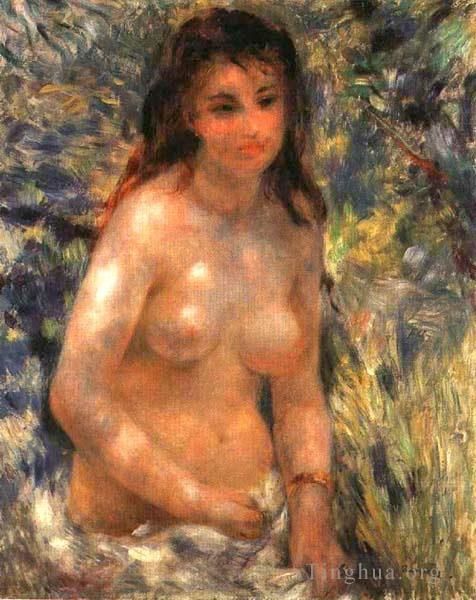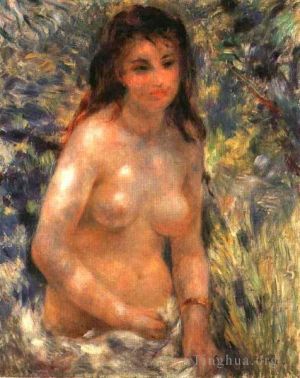Nude in the sunlight
Pierre-Auguste Renoir
- Price: Price on Request
- Art Type: Oil Painting
- Size:
- English Comments: 0
- International Comments: 0
- Creating Date:
- Introduction and Works of Pierre-Auguste Renoir >>
Work Overview
- Nude in the sunlight (Study Torso Sunlight Effect)
Pierre-Auguste Renoir
Date: c.1876
Style: Impressionism
Period: Association with Impressionists
Genre: nude painting (nu)
Media: oil, canvas
Dimensions: 80 x 64 cm
Location: Musée d'Orsay, Paris, France
Rodin believed that Van Gogh and Renoir were the two greatest painters of their generation.The sculptor was particularly attached to this painting that he was able to purchase from Bernheim-Jeune in 1910, but which he had wanted since 1898. It dates from the period when Renoir, heedful of Ingres and Raphael’s teachings, began distancing himself from Impressionism and giving priority back to line and contours.
Handled like a sketch, this seated young woman attests to the distinctive sculptural qualities found in the painter’s finest nudes. The visible juxtaposed dabs of pure colour form a sort of halo, or mandorla, around the voluptuous female nude. The soft modelling of the body seems to have emerged out of a hazy background, establishing an effect of contrast that could not fail to please Rodin.
A photograph taken at the time shows the painting hanging on the wall – a rare occurrence – above Rodin’s desk in the Hôtel Biron. The sculptor loved to show it to people and comment upon it: “The torso of this young woman is pure sculpture. What a marvel!” (Tirel, 1923). “Look at this Nude by Renoir, look at the quality of this flesh; it shines in the night: it’s a real Praxiteles!” (Revers, 1911).
Renoirs work did shock people in the beginning. When he exhibited his paintings at Société Anonyme, a show in Paris in 1874, critics were dismayed to see simple oil sketches presented as finished works. Two years later his painting Nude in the Sun (also known as Woman's Torso in the Sunlight) was badly received by critic Albert Wolff who claimed he wanted to: "Try to explain to M Renoir that a woman's torso is not a mass of decomposing flesh. " Wolffs contempt for the piece stemmed from the fact that he saw it very much as modern art.
It was clear that Renoir and his associates did not follow the same rules as other artists of the time. They were committed to producing light-suffused paintings which excluded black but this technique was so far removed from traditional formulas that their works were regularly rejected by the Salon, and were difficult to sell.
Out of a riot of glittering brush strokes rises this stunning Nude in the Sunlight. "The most simple subjects are eternal," said Renoir. "The nude woman, whether she emerges from the waves of the sea, or from her own bed, is Venus, or Nini; and one's imagination cannot conceive anything better." The coloring and texture of the body indeed suggest rare sea-shell tints.
Evidently Renoir was delighted with the freshness and spontaneity of this sketch and chose to leave it so. The pearl-like shape and luster of the forms is the major theme, given in the round mass of the haunches and belly, the breasts, shoulders, head, and echoed in the roundness of arms and neck; and a dappled sunlight that plays across the arms and body sustains this motif. Nothing is allowed to distract from the fullness: notice how Renoir has virtually eliminated surface markings like the nipples and navel.
The girl is completely a thing of nature; only Renoir's recurrent bracelet and ring betray a note of feminine vanity. The grasses suddenly part, the scene becomes to our eyes a hubbub of color streaks, and before us is this unforgettable vision of a forest creature, a Rima to delight and trouble the senses.
- Copyright Statement:
All the reproduction of any forms about this work unauthorized by Singing Palette including images, texts and so on will be deemed to be violating the Copyright Laws.
To cite this webpage, please link back here.
- >> English Comments
- >> Chinese Comments
- >> French Comments
- >> German Comments
- >>Report
- Woman with a cat
- Irene cahen danvers
- Girl with a basket of fish
- Portrait of ambroise vollard
- The umbrellas
- The artists family
- Champs elysees paris fair
- A Girl with a Watering Can
- Bouquet of roses flower
- At the concert
- Gabrielle with bare breasts
- The gust of wind
- Mixed Spring Flowers
- Riding in the bois de boulogne
- Woman with a parasol
- Place clichy
- Young girl with a parasol
- Henry Onions still life
- Apres le bain
- Nude in the sunlight
- Girl streched out on the grass
- Daughters of catulle mendes
- The Grands Boulevards
- Jeanne samary 1878
- Woman gathering flowers
- Dance at Le moulin de la Galette
- Study Summer
- Dance at Bougival
- Young woman with a japanese umbrella
- The washer women
- The Bathers
- Young spanish woman with a guitar
- At The Theatre
- Aline and pierre
- Lanscape in la roche guyon
- Banks of the seine at champrosay
- The vintagers
- Leaving The Conservatoire
- Self portrait
- Gabrielle and jean
- Study Torso Sunlight Effect
- Reclining nude 1890
- The farm
- Monet painting in his garden at Argenteuil
- Jeanne durand ruel
- Mother anthonys inn at marlotte
- Parisiennes in algerian dress
- August madame 1872
- Madame monet lying on sofa
- La Promenade
- Luncheon of the Boating Party
- Roses in front of a blue curtain flower
- Landscape at vetheuil
- Vase of Chrysanthemums
- Gypsy girl
- Still life with flowers
- Three bathers
- The blue river
- Apples and Flowers
- Woman tying her shoelace
- Odalisque (An Algerian Woman)
- The Doges Palace
- Charles and georges durand ruel
- Woman standing by a tree
- Young girl reading
- The Dancer
- Claude Monet Reading (Reading A Newspaper)
- Girl with a Straw Hat (Young Girl in a Straw Hat)
- Portrait of richard wagner
- View of Venice Fog
- Landscape between storms
- Woman playing the guitar
- The laundress
- A box in the theater des varietes
- Fruits from the Midi
- Claude playing
- Madame charpentier
- Young woman seated
- Young Girls at the Piano
- Portrait Of The Actress Jeanne Samary
- Julie manet
- Romaine Lascaux
- Lady in a white hat
- Still Life With Bouquet
- Madame henriot
- The first step
- Terraces at Cagnes
- Gabrielle in a red blouse
- Lady with a veil
- Monsieur fournaise
- Alphonsine fournaise
- Two Girls Reading
- Landscape at cagnes
- Bouquet in front of a Mirror
- Portrait of Alfred and Marie Sisley
- Casbah
- Blonde Bather
- Girl with a basket of oranges
- The Apple Seller
- House in collett at cagnes
- After the bath
- Madame Monet and Her Son
- Railway bridge at chatou
- Path Leading through Tall Grass
- Nude on cushions
- Oarsmen at chatou
- Woman combing her hair
- Jeanne Samary in a Low Necked Dress
- Girl With A fan
- Rocky craigs at lestaque
- Portrait of alfred sisley
- Andree in blue
- Woman reading
- Maison de la poste cagnes
- Enoir picking flowers
- Gabrielle with jean and little
- Washerwomen
- La Grenouilliere
- Summer hats
- A Bather (Bather is Styling)
- Pensive
- Young woman with a dog
- Head Of A Woman
- Young woman wearing a hat with wild roses
- The Large Bathers
- Portrait of jeanne samary
- In the Meadow
- The pont neuf paris
- Marie murer
- Portrait of jean frederic bazille
- Therese berard
- Mother and children
- Strawberries
- The Seine at Asnieres (The Skiff)
- Jugglers at the cirque fernando
- Woman by a fence
- Laundresses
- The Theatre Box (La Loge)
- Flowers in a vase 1866
- Portrait of coco
- Bather with Blonde Hair
- The spring
- The canoeists luncheon
- Woman in a park
- Gabrielle with a rose
- The luncheon
- Dance in the Country
- Yvonne and christine lerolle playing the piano
- The artists son jean
- Mosque in algiers
- Woman In Black
- Sailboats at argenteuil
- Lise with an Umbrella
- Piazza san marco venice
- The parisian
- Young boy with a cat
- Portrait of a girl
- By the seashore
- La mere aux oies
- Torso Before the Bath The Toilette
- Sleeping bather
- Woman at the piano
- Girl wiping her feet
- Georges riviere
- Landscape
- Bathers 1910
- Garden in rue cortot montmartre
- Bather on a rock
- Sleeping girl with a cat
- Portrait of madame chocquet
- Portrait actress jeanne samary
- The first outing
- Nini in the garden
- A girl with a watering can Pierre Auguste Renoir
- Bather with Long Hair
- Portrait of claude monet
- Girl with a hoop
- Young girl combing her hair
- Madame and bob
- Fisherman on riverbank
- Andree in yellow turban and blue skirt
- Claude monet
- The swing
- Child With A Whip
- Regatta at argenteuil
- Anemones flower
- Peaches on a plate still life
- 5 la promenade
- Mixed Flowers In An Earthenware Pot
- Mlle charlotte berthier
- The horsewoman
- Seated Bather
- Mother and child (Motherhood or Woman Breast Feeding Her Child)
- Woman at the fountain
- Young shepherd in repose
- Diana
- Mademoiselle sicot
- The Rambler
- View of antibes
- Portrait of victor chocquet 75
- Roses and jasmine in a delft vase flower
- After the luncheon
- Jules le couer in fontainebleau forest
- Bathers
- Young woman wearing a hat
- Yvonne and jean
- Beach scene guernsey
- Woman with a mandolin
- The bather
- Dance in the City (City Dance)
- Madame charpentier and her children
- The coiffure
- Skaters in the Bois de Boulogne
- Bather Arranging her Hair
- Still life with peaches and grapes
- Claude monet reading
- Head of a dog
- Madame Renoir with a Dog
- Portrait of william sisley
- The garden in montmartre
- Madame Georges Charpentier and her Children
- At the Luxembourg Gardens
- La Grenouillere
- Young women talking
- The Pont des Arts, Paris (The Pont des Arts and the Institut de France)
- Bouquet of spring flowers
- Bernheim de villers
- Two Sisters (On the Terrace)
- The meadow
- Child in white
- Tilla durieux
- Young woman braiding her hair









 Singing Palette
Singing Palette